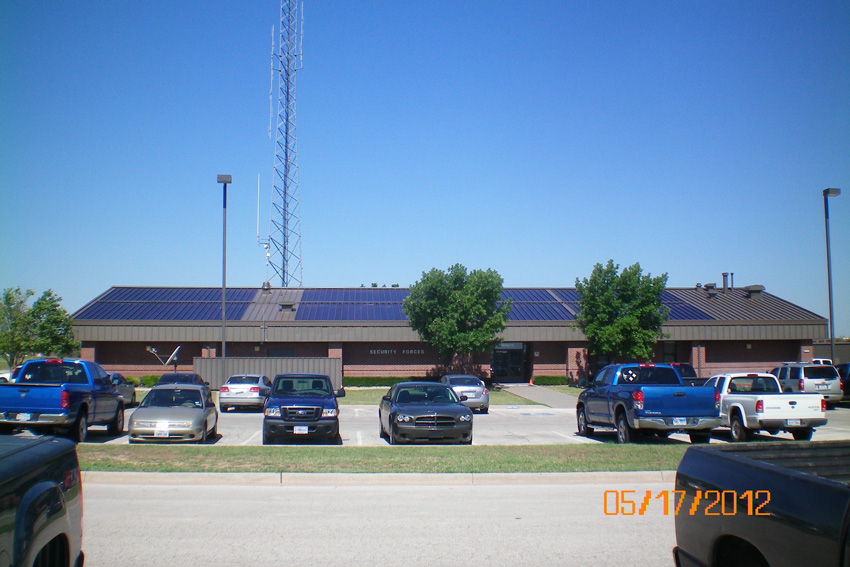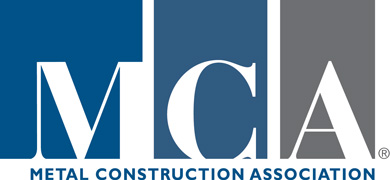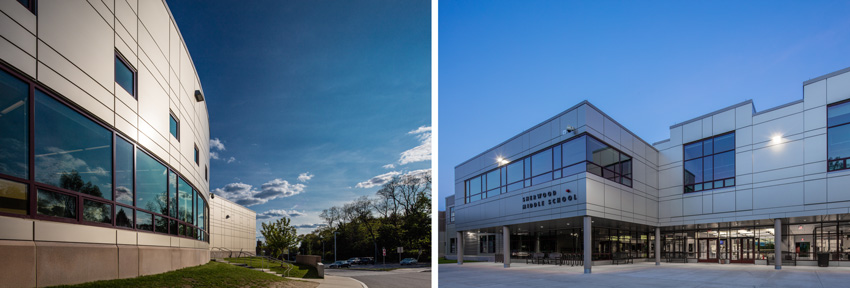Put the Pedal to the Metal
Case in Point
As part of the U.S. Department of Defense’s (DOD) mandate to produce or procure 25 percent of all DOD building energy from renewable sources by 2025, reduce energy use by 30 percent by 2015, and another 37.5 percent by 2020, San Angelo, Texas’ Goodfellow Air Force Base received a new metal roof integrated with energy-efficient technologies.

Photo courtesy of Paramount Metal Systems LLC
Utilizing data gathered from a U.S. Department of Energy Oak Ridge National Laboratory-installed data acquisition system to monitor San Angelo, Texas’ Goodfellow Air Force Base’s temperature and heat information, a highly sustainable 11,900-foot metal roof retrofit with photovoltaics, boosted insulation levels, a solar thermal system, and rainwater collection was installed.
After gathering key building energy performance data and utility billing information, the former collected from a DOE ORNL-installed data acquisition system to monitor the building’s temperature and heat information, a baseline energy usage was established.
A highly sustainable 11,900-foot metal roof retrofit with photovoltaics, boosted insulation levels, a solar thermal system, and rainwater collection was then executed. While many reroofing projects have incorporated such technologies, the Goodfellow AFB was unique in that the energy-saving technologies were integrated into the new roof to form the building envelope.
Essentially, the roofing system components were integrated into one retrofit system to maximize electricity generation and minimize the building’s cooling load. For example. the solar-thermal technology sits inside the roof cavity to optimize energy generated for domestic hot water and space heating. The system is anticipated to generate more than 750,000 KBTU of energy per year and save $11,750 in annual energy costs.
Furthermore, a 10,000-gallon cistern captures approximately 131,000 gallons of potable water for irrigation.
In the process of installing these integrated technologies, first, structural purlins were installed over the existing metal roof. Next, additional insulation in the form of rigid insulation board was placed over the existing roof, and a waterproof roof underlayment was applied over the insulation. After that, a radiant barrier was installed over the underlayment, and then the integrated solar-thermal system was installed over the radiant barrier to optimize heat transfer.
In addition, a thermal purlin is used to position the solar thermal system tubing and configured to support above-sheathing ventilation to take place from the eave to the ridge.
Finally, 24-gauge standing-seam metal roofing panels, prepainted with a polyvinylidene fluoride cool coating, were laminated with a thin-film PV system and installed directly over the solar-thermal system.
Best Practices
Sharing a few best practices for retrofitting metal-over-flat and metal-over-sloped roofs, Mark James, president of RetroSpec LLC in Dallas, emphasizes that first and foremost, the existing roof support system must be identified. This includes the type of system, spacing of secondary members, decking type, insulation thickness, and weathering membrane.
“Once this is completed, then the design of a new light-gauge structural framing system can be determined and estimated,” he explains. “Design professionals and contractors must understand that the existing roof support system controls everything in the new framing’s base member type and that the placement of the vertical members will support new roof purlins. The new roof purlin spacing is controlled by the new metal roof system’s tested values for wind uplift and gravity load.”
Proper anchorage is also key in order to prevent wind uplift from tearing the new roof off of the existing roof. Furthermore, wind uplift performance should be updated to comply with the current building code requirements.
For metal over flat, the added weight of a sloped build-up retrofit system is 2 to 5 pounds per square foot (PSF), and for metal over sloped, it’s 1.5 to 2 PSF. The structure should be tested with a series of concentrated loads as opposed to uniform loads.
“A critical factor is ensuring a good sound substrate on which the new roof can be installed,” adds Feth. “In addition, all penetrations, changes in plane, and transitions to other building elements must be detailed/sealed properly. Each manufacturer will have their own suggested details for various conditions.”
Choosing Metal
Whether it’s metal’s exceptional longevity, durability, recyclability, compatibility with solar technologies, or the energy efficiencies delivered by metal roof retrofits, metal walls and rooms are an excellent sustainable choice for today’s commercial buildings.
End Notes
1Kazlov, Paul. “Metal Roofing: An Unlikely Way to Reduce Waste and Save Energy.” Triple Pundit. 6 August 2014. Web. 30 August 2017. www.triplepundit.com/2014/08/metal-roofing-unlikely-way-reduce-waste-save-energy
2Government Product News Staff. “Expert: Metal buildings offer versatility to governments.” American City & Country. 14 April 2015. Web. 30 August 2017. www.mbma.com/media/American%20City%20and%20County%20Reprint.pdf
3Deffenbaugh, Paul. “31st Annual Architect’s Survey.” Metal Architecture. March 2017. Web. 30 August 2017. www.metalarchitecture.com/articles/magazine-features/31st-annual-architect-survey.aspx
4Walter P. Moore and Associates. “Athena Impact Estimator Case Studies.” August 2015. Web 30 August 2017. www.mbma.com/media/WalterPMooreAthenaImpactorCaseStudies-MBMA_Aug2015.pdf
5“ASMI accepts MCA report on increased service life of metal roofing.” Construction Magazine Network. 26 August 2015. Web. 30 August 2017. www.constructionmagnet.com/metal-roofing-magazine/asmi-accepts-mca-report-on-increased-service-life-of-metal-roofing
6“Metal Roofs and Walls: Promoting the Future of ‘Green’ and Sustaining the Environment.” BOMA International. 2006. Web. 30 August 2017. www.boma.org/research/Documents/Find%20a%20Resource/Metal.pdf
7Konopacki, S. and Akbari, H. “Measured Energy Savings and Demand Reduction from a Reflective Roof Membrane on a Large Retail Store in Austin.” Lawrence Berkeley National Laboratory. January 2001. Web. 30 August 2017. www.vinylroofs.org/wp-content/uploads/2011/06/LBNL_study-1.pdf
8“Guidelines for Selecting Cool Roofs.” U.S. Department of Energy Building Technologies Program. July 2010. Web. 30 August 2017. heatisland.lbl.gov/sites/all/files/coolroofguide_0.pdf
9Taha, Haider and Akbari, Hashem. “Cool Roofs as an Energy Conservation Measure for Federal Buildings.” Lawrence Berkeley National Laboratory. April 2003. Web. 30 August 2017. pubarchive.lbl.gov/islandora/object/ir%3A120601/datastream/PDF/download/citation.pdf
10Casey, Tina. “What Color is Your Parking Lot: New Research Combats Heat Island Effect.” Triple Pundit. 17 September 2012. Web. 30 August 2017. www.triplepundit.com/2012/09/heat-island-effect/
11“Retrofit Roofs Offer Design, Environmental, and Financial Benefits in New and Existing Construction.” Metal Construction Association. August 2016. Web. 30 August 2017. www.metalconstruction.org/download.php/education/tech_resources/retrofit/WhitePaper_BenefitsRetrofitRoofing
12Haddock, Rob. “Rooftop Equipment Mounting and Penetrations for Low-Slope Standing-Seam Metal Roofs.” Roofing. 3 November 2013. Web. 30 August 2017. www.roofingmagazine.com/author/rob-haddock/
13“Retrofit Re-Roofing with Metal Roof Systems.” Metal Construction Association. Web. 30 August 2017. www.metalconstruction.org/index.php/education/educationalresources

|
The Metal Construction Association brings together a diverse industry for the purpose of expanding the use of metal in construction through marketing, research, technology, and education. MCA member companies gain tremendous benefit from association activities that focus on research, codes and standards, market development, and technical programs. www.metalconstruction.org |










